Sonic Innovations F2ITE01 HearingAid User Manual UserGuide
Sonic Innovations, Inc. HearingAid UserGuide
UserGuide.pdf
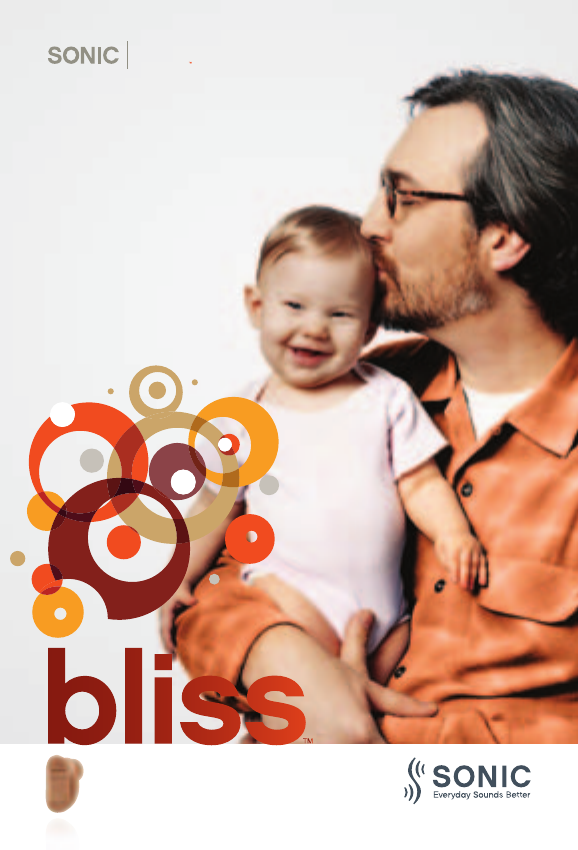
Bliss Custom Instruments
User Guide
bliss
bliss

SONIC · BLISS
02
Hearing Instrument Serial Number:
Left Right
Hearing Instrument Model:
Left Right
Battery Size:
Listening Listening
Program # Environment
1
2
3
4
Right & Left Instruments Synchronized
r Active r Inactive
Program Button: Program Button Mute:
r Active r Inactive r Active r Inactive
Telephone Coil (ITEPDW and ITCPDW)
r Right r Left r Disabled
Preferred Telephone Ear Non-Telephone Ear
Control
r Right r Softer
r Left r Mutes
r Both r No Change
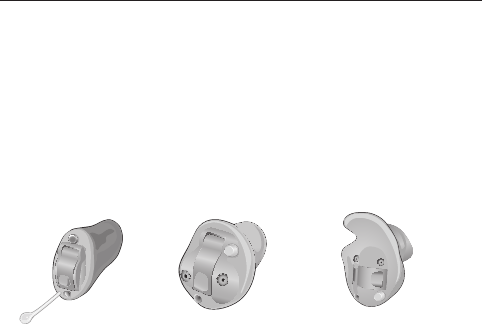
03
The following hearing instruments are covered
in this User Guide:
Bliss Custom Instruments
BL100 CIC/CICP BL100 ITCPDW BL100 ITEPDW
BL80 CIC/CICP BL80 ITCPDW BL80 ITEPDW
BL_ILLU_ITIPDW_BW
11
BL_ILLU_ITCPDW_BW
9
3BL_ILLU_CIC_BW
Bliss · Custom user guide

04 SONIC · BLISS

05
Bliss · Custom user guide
Table of Contents
Congratulations On Your Purchase! 09
General Warnings and Safety Guidelines 10
Hearing Expectations 15
Your Bliss CIC/CICP Hearing Instrument 17
Your Bliss ITCPDW Hearing Instrument 18
Your Bliss ITEPDW Hearing Instrument 19
Turning Your Hearing Instrument OFF and ON 20
Putting On Your Hearing Instrument 21
Taking Off Your Hearing Instrument 22
Changing the Volume 23
Changing the Programs 24
Using the Telephone 26
Using the Telephone Coil 29
Changing the Battery 30
Data Logging and Learning 33
Caring for Your Hearing Instruments 34

06 SONIC · BLISS

07
BLISS · CUSTOM USER GUIDE
Operating your Bliss with the RC-P Remote Control 41
Operation Your Bliss with the SoundGate
Communication Device 42
Environmental Protection 43
Product Approval, Markings and Compliance 44
Cell Phone and Hearing Instrument Compatibility 46
Warrenty and Repairs 48
Accessories 49
Common Problems and Solutions 50
Information for the Hearing Care Provider 54
Compliance with Requirements for Europe 56
Compliance with Radio Communications
Requirements for the USA and Canada 57
Information and Explanation of Symbols 60
Service 62
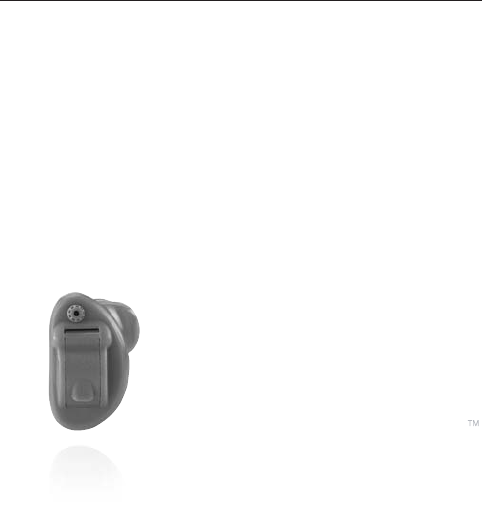
08 sonic · BLiss
bliss

09
Bliss · Custom user guide
Congratulations On Your Purchase!
With a little practice, you will soon be on your
way to better hearing. The amplification of
sound provided by your hearing instruments
was adjusted by your health care provider
to the needs of your individual hearing loss.
Please read the entire contents of this booklet before
using your hearing instruments. It contains instructions
and important information about the use and handling
of your hearing instruments and batteries. With proper
use and care, your hearing instruments will improve
your connection with the world around you.

10 sonic · BLiss
General Warnings and Safety Guidelines
Hearing instruments and batteries can be dangerous if
swallowed or improperly used. Such actions can result
in severe injury, permanent hearing loss or even
fatality.
Familiarize yourself completely with the following
general warnings and safety guidelines before using
your hearing instruments.
Hazard Warnings
Never allow others to wear your hearing instru-
ments. They are adjusted for your hearing re-
quirements and may permanently damage
another person’s hearing.
Avoid wearing your hearing instrument while
playing contact sports (e.g. rugby, football etc.),
since a strike to the ear could be harmful.
Hearing instruments, their parts and batteries
should be kept out of reach of infants, children
and anyone who might swallow these items
or otherwise cause themselves injury.
Take care when changing and discarding
batteries to keep them out of reach of infants,
children, persons of mental incapacity or pets.

11
Bliss · Custom user guide
Clean your hearing instruments and their parts
on a regular basis as recommended. Micro-
organisms from unclean instruments may cause
skin irritations.
Be careful with leaking battery liquid, as it is
a hazardous substance.
Never attempt to recharge non-rechargeable
batteries.
Be aware of the possibility that your hearing
instruments may stop functioning without notice.
Keep this in mind while you circulate in traffic
or otherwise depend on warning sounds.
Remove your instruments before applying
aftershave, hairspray, oils, perfume, mosquito
repellent, lotions, etc. Allow the product
to dry before wearing your instruments.
Traffic or other warning sounds may be reduced
in level by a directional microphone when these
sounds are coming from behind you.

12 sonic · BLiss
Warning to Hearing Care Provider and Patient
Special care should be taken when fitting and
using a hearing instrument with maximum
sound pressure capability in excess of 132 dB SPL
(IEC 60318-4) since there may be a risk of impair-
ing the remaining hearing of the patient.

13
Bliss · Custom user guide
Safety Information
·Hearing instruments should be used only as directed
and adjusted by your trained hearing care provider.
Misuse or improper adjustments can result in sudden
and permanent hearing loss.
·Never put your hearing instrument or batteries
in your mouth, as they could easily be swallowed
·Keep batteries away from medications, since
they can easily be mistaken for pills
·In the event that a battery or hearing instrument
is swallowed, see a doctor immediately
·Be aware that use of a hearing instrument may cause
excess earwax to build up in the ear canal which may
require removal by a trained medical professional
·Consult your physician if excessive earwax, skin
irritation, or a foreign object prevents you from
wearing your hearing instrument
·An in-the-ear hearing instrument is a custom-made
product. If you experience discomfort or irritation
of your ear, please see your hearing care provider
immediately for modification of the shell.
·In rare cases, a hearing instrument or earmold may
cause a discharge from the ear or allergic reaction.
See a physician immediately if these conditions occur.

14 sonic · BLiss
·Never insert cleaning tools into the microphone inlet
or deeply into the sound outlet. This could damage
the hearing instruments.
·Do not expose hearing instruments to extreme
heat by leaving them in the car, near a radiator, etc.
·Avoid exposing your instruments to water and
moisture i.e. steambaths, showers, heavy rain, etc.
·Never attempt to dry your instruments with
a hair dryer, microwave oven, etc.
·It is recommended to remove your hearing
instruments before sleeping
·Protect your instruments by keeping them in
the case when you are not wearing them

15
Bliss · Custom user guide
Hearing Expectations
Set Appropriate Expectations
It is important that you have the right expectations
regarding your hearing instruments. Hearing
instruments will give you better hearing, but they
are not a cure for hearing loss.
People whose expectations are too high (“I thought
they would make my hearing normal”) are likely to be
disappointed and may give up.
Hearing Instruments Can:
·Help you hear and understand better in most
situations
·Allow you to participate more in group situations
and meetings
Hearing Instruments Cannot:
·Give you normal hearing
Hearing Instruments May Not:
·Let you hear very soft sounds
·Block ALL background noises – especially in noisy
situations. Even people without hearing loss may
have difficulty hearing in the presence of background
noise.

16 sonic · BLiss
Be Patient
Unlike with eyeglasses which correct your vision
as soon as you first put them on, with hearing
instruments you will need some time to adjust.
It may take several weeks or months to completely
adjust to your hearing instruments, so try to be
patient. Initially, try different listening situations,
such as one-on-one conversations with family
and friends and conversations with two or three
people at home or in quiet settings. Also, try
having conversations in noisier places like parties,
restaurants, meetings, and outdoors.
Do not forget that some situations are simply too noisy
in general – even for people without hearing loss.
So do not get discouraged.
Consistent use of your hearing instrument is strongly
recommended. In most cases, infrequent use does
not allow you to obtain the full benefit from your device.
The use of a hearing instrument is only a part of total
hearing rehabilitation, and may need to be supple-
mented by auditory training and instruction in lip
reading.
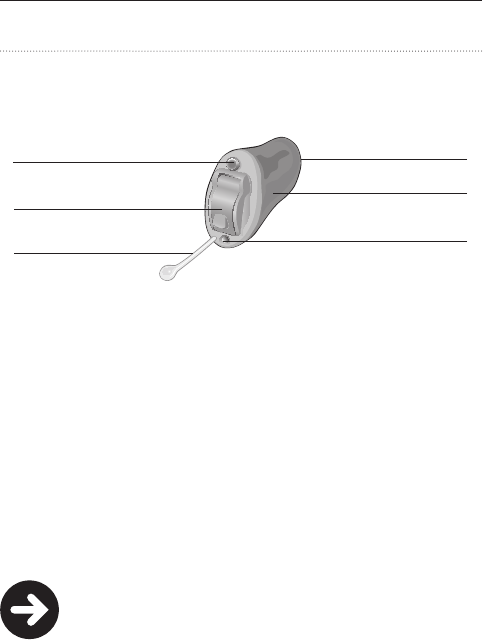
17
Bliss · Custom user guide
3BL_ILLU_CIC_BW
Your Bliss CIC/CICP Hearing Instrument
1 Microphone Opening
2 Battery Door
3 Removal Cord
4 Air Vent
5 Canal
6 Sound Outlet with Wax Protection
1
2
34
6
Note!
Bliss CICP can be built with an optional
Program Button. Your hearing care provider
will determine whether it is necessary to
include this option on your hearing instrument.
5
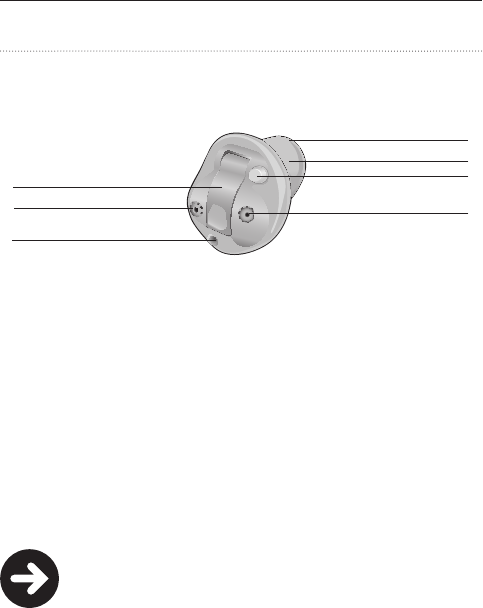
18 sonic · BLiss
BL_ILLU_ITCPDW_BW
9
1 Microphone Openings
2 Battery Door
3 Air Vent
4 Program Button
5 Canal
6 Sound Outlet with Wax Protection
1
2
3
4
5
Your Bliss ITCPDW Hearing Instrument
1
6
Note!
Bliss ITCPDW can be built with an optional
Program Button. Your hearing care provider
will determine whether it is necessary to
include this option on your hearing instrument.
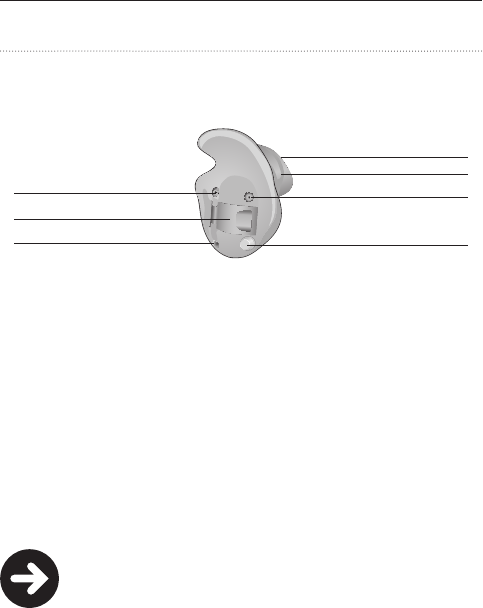
19
Bliss · Custom user guide
BL_ILLU_ITIPDW_BW
11
Your Bliss ITEPDW Hearing Instrument
1 Microphone Openings
2 Battery Door
3 Air Vent
4 Program Button
5 Canal
6 Sound Outlet with Wax Protection
1
2
1
Note!
Bliss ITEPDW can be built with an optional
Program Button. Your hearing care provider
will determine whether it is necessary to
include this option on your hearing instrument.
34
5
6
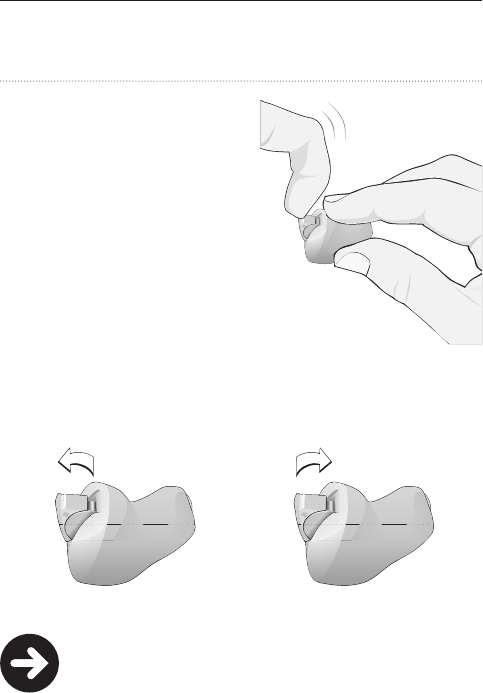
20 sonic · BLiss
Turning Your Hearing Instrument
OFF and ON
To Turn the Instrument OFF
Place your fingernail
underneath the front
edge of the battery door
and lift to open.
To Turn the Instrument ON
Push the battery door closed
until it snaps. The hearing
instrument will make one
long beep as it starts.
Note!
Never force the battery door open or closed.
open (OFF) closed (ON)
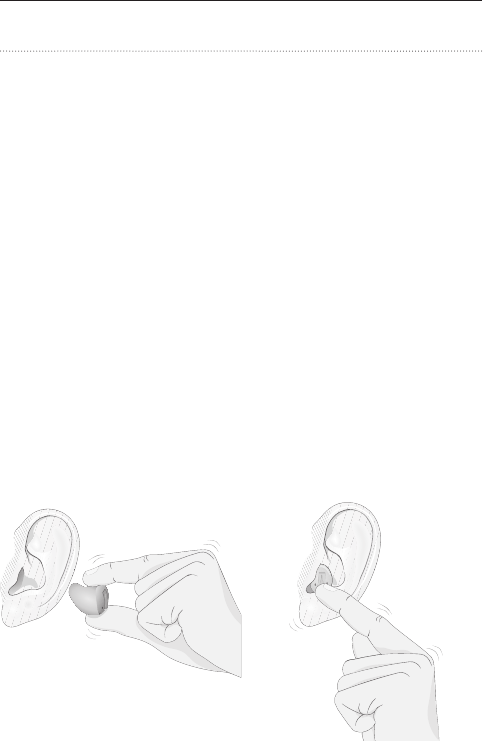
21
Bliss · Custom user guide
Putting On Your Hearing Instrument
It takes patience and practice to insert your
instruments correctly. If you have difficulty, please
consult your hearing care provider.
·Insert your right instrument with your right hand
and your left instrument with your left hand
·Hold your instrument between your thumb
and index finger
·Place the canal part of your instrument into your
ear canal
·Gently pull your ear lobe down with the other hand
while pushing the hearing instrument in until it
feels secure

22 sonic · BLiss
Taking Off Your Hearing Instrument
·Use your thumb to push up against the bottom
(back part) of your ear to loosen the instrument
·Grasp the instrument at its edge between your
thumb and forefinger, and gently remove it from
your ear
·If your hearing instrument has a removal (pullout)
cord, pull it gently
Note!
Do not try to remove your instrument by
pulling on the battery door. This may cause
damage. Contact your hearing care provider
if you are having problems removing the
instrument.

23
Bliss · Custom user guide
Changing the Volume
Your hearing instruments are programmed to be at
a comfortable volume level for your hearing loss.
They are designed to automatically adjust to changes
in the sound environment. Some models (ITEPDW,
ITCPDW) allow you to adjust the volume yourself,
with an optional remote control.
RC-P Remote Control or SoundGate
(Optional accessories for ITEPDW, ITCPDW)
If you have purchased an RC-P remote control or
SoundGate accessory, you can use it to make small
volume changes to get a natural and comfortable
sound. Please see pages 41 and 42 for further
instructions.
Note!
If the default volume of your hearing instrument
is too loud or soft, your hearing care provider
may need to make changes to your listening
program.
Note!
Your hearing instruments automatically return
to a pre-set loudness level when they are
powered on, when the battery is low, or when
the program is changed. If you find that you
frequently need to turn the volume up or down,
your hearing care provider may need to adjust
your settings.

24 sonic · BLiss
Changing the Programs
If your instrument has a program button, your hearing
care provider can program it to change programs.
Please see inside the front cover of this User Guide to
find out which program(s) have been configured by
your hearing care provider. You can change programs
as follows:
Program Button
(Optional ITEPDW, ITCPDW, CICP)
A short press (about 2 seconds) on the program button
will cause the listening program to change. You will
hear the same number of beeps as the program
you are in each time you push the button. When you
turn the hearing instrument off and then on, it will
automatically return to your default listening program
(program 1).
RC-P Remote Control or SoundGate
(Optional accessories for ITEPDW, ITCPDW)
The listening program can be changed with either
of these devices. Please see pages 41 and 42 for
instructions.
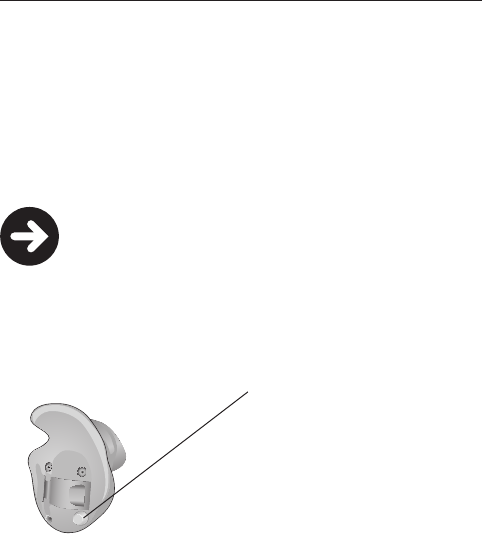
25
Bliss · Custom user guide
BL_ILLU_ITIPDW_BW
11
Program Button Mute
(Optional ITEPDW, ITCPDW, CICP)
A longer press (about 5 seconds) on the program
button will cause the hearing instrument to mute,
no matter which program you are in. Press the
button again to un-mute the device.
Note!
Your hearing care provider can customize
the behavior of the program button.
Please see inside the front cover to find
out how your control may have been
configured.
Program Button

26 sonic · BLiss
Using the Telephone
Your hearing instrument may be programmed with
a dedicated Telephone program, Auto Telephone
and/or Telephone coil option. Please see inside the
front cover to find out if this was configured.
If your hearing instrument has been configured
without these options, select the program that is best
for you when using the telephone. Then position
the phone lightly against your ear as described on
page 28.
Auto Telephone
(Optional for ITEPDW and ITCPDW)
Your hearing instrument may have an optional Auto
Telephone feature. When the hearing instrument
is close to a telephone receiver, the Auto Telephone
will activate your telephone listening program. When
you end your conversation, the hearing instrument
will automatically return to the previous listening
program. Your hearing care provider can configure
your hearing instruments to allow answering the
phone on both ears or on your preferred ear.
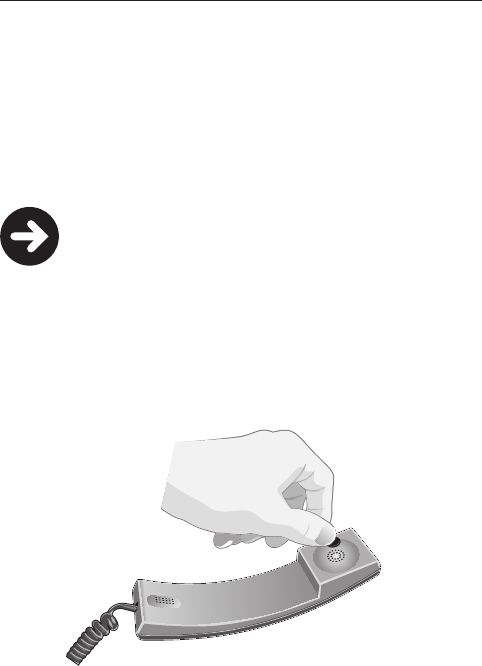
27
Bliss · Custom user guide
Bliss100 ITEPDW and ITCPDW Only
If you have a preferred ear, the hearing instrument
on the opposite side can be programmed to sound
softer or mute when the Auto Telephone is active.
Refer to the information inside the front cover to find
out how your hearing instruments are configured.
Note!
Some telephones may need a special magnet
added to help engage the Auto Telephone
feature. To mount the magnet onto your
telephone, please follow the instructions
included in the magnet’s packaging
or contact your hearing care provider.

28 sonic · BLiss
Phone Usage Tips
·Hold the telephone receiver close to your hearing
instrument. If this causes whistling, move
the telephone receiver away a small distance.
·Before purchasing a mobile phone, test it with
your hearing instrument
·People with a greater degree of hearing loss
may need a volume control on the telephone
Magnet Warning
·Keep magnets out of reach of children and pets
·If a magnet is swallowed, see a doctor immediately
·Do not place the magnet in a shirt pocket and keep it
1 ft (30 cm) away from pacemakers and other active
implants
·Use the magnet on the opposite side from active
implantable devices
·Keep the magnet 1 ft (30 cm) away from credit cards
or other magnetically sensitive items

29
Bliss · Custom user guide
Using the Telephone Coil
(Optional for ITEPDW and ITCPDW)
The telephone coil helps you hear better when using a
telephone or in buildings where inductive loop systems
are installed (places of worship, halls, theater, etc.).
When the telephone coil is active, you hear directly
through the telephone or inductive loop. To access
the telephone coil, go to the telephone program.
Please refer to inside cover to see if this option has
been configured for your device.
This symbol or a similar sign should be
displayed wherever a permanent loop
has been installed.
Note!
Not all telephones are compatible with
hearing instruments.
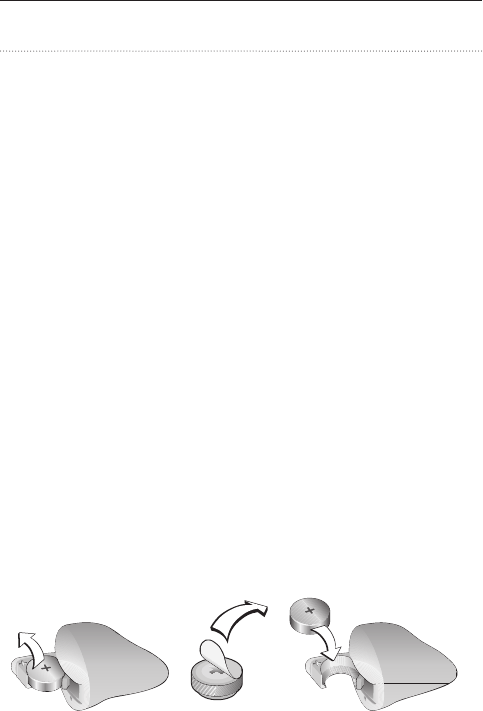
30 sonic · BLiss
Changing the Battery
When the battery is running out, the instrument will
beep at regular intervals. You should be prepared
to replace the battery. The time until the instrument
stops working depends on the battery type and
manufacturer. Mercury-free batteries generally
cause earlier warning beeps.
The following battery sizes are used:
·CIC and CICP: size 10A battery
·ITCPDW: size 312 battery
·ITEPDW: size 13 battery
·Gently swing the battery door fully open, but
do not force it
·Take out the used battery (Fig. 1)
·Remove the sticker from the new battery (Fig. 2)
·Place the battery into the door with the flat, smooth
side facing up (+ sign) as shown in the drawing (Fig. 3)
·Close the battery door securely
Fig. 1Fig. 2 Fig. 3

31
Bliss · Custom user guide
Change Batteries Regularly
When your battery needs to be changed you will hear
three beeps: a low tone, followed by a high tone and
another low tone. The exact battery life you experience
may vary. The table below provides an estimate of how
often to change the battery:
If your hearing instrument is not in use, open
the battery compartment door to turn the device off.
This will prevent battery drain.
Note!
Never force the battery door open or closed.
Bliss Model Battery Size Change Every*
CIC #10A Est. 8 days
CICP #10A Est. 8 days
ITCPDW #312 Est. 12 days
ITEPDW #13 Est. 21 days
* Estimated number of days based on a 12 hour/day wearing
schedule

32 sonic · BLiss
Important Battery Information
·Battery life will vary with conditions of use
(for example, batteries will run down faster
in noisy environments)
·Always keep spare batteries on hand
·A used battery should be replaced immediately
·If you are not going to use your hearing instruments
for a few days, remove the batteries
·Any moisture found on a battery should be wiped
off immediately with a soft cloth
·Always remove zinc-air batteries before drying
your hearing instrument with a drying kit.
Drying out zinc-air batteries shortens their lifetime.
·Used batteries should be returned to your battery
supplier or hearing care provider for safe disposal
·Never dispose of batteries by burning them.
They may explode and cause injury.
·Never dispose of batteries with household waste.
They cause environmental pollution.
·Batteries can be harmful if swallowed. Keep batteries
out of the reach of pets and small children. In case
of ingestion, contact your physician immediately.

33
Bliss · Custom user guide
Data Logging and Learning
Data Logging
The data log automatically stores information about
your use of the hearing instruments such as changes
made to the volume control, hours of wear, etc.
This information can be used by your hearing care
provider to adjust your instruments. If you do not
want this feature to be active, please ask your hearing
care provider to turn it off.
Data Learning (Bliss100 ITEPDW and ITCPDW Only)
If your instrument is equipped with data learning,
your hearing care provider can activate this feature
to help customize your hearing instruments. When
data learning is operating, the instrument keeps track
of how often and how much you adjust the volume
control and “learns” your preferred setting. This new
setting can be made permanent during your follow-up
visit.

34 sonic · BLiss
Caring for Your Hearing Instruments
Healthy ears produce cerumen, a waxy substance
that can clog your hearing instruments. Please
follow these simple cleaning instructions to prevent
wax build-up and ensure optimal performance.
Every Night
·Check your hearing instruments for ear wax
and wipe them clean with a cloth or tissue
·If necessary, use the cleaning tool to remove wax
from the canal and vent openings on your instrument
·Open the battery door fully to allow air to circulate
·A dry storage kit is recommended to remove
any moisture that may have accumulated in
the hearing instrument

35
Bliss · Custom user guide
Cleaning the Sound Outlet
The sound outlet is an integral part of your hearing
instrument and should be kept clean and free from
cerumen (ear wax) at all times. Your instruments
are built with a wax protection system. Please follow
the instructions for using ProWax below. If you have
questions, please ask your hearing care provider.
How to Replace ProWax
·Take a new removal tool.
The tool has two arms,
one with the new filter
and one with the removal tool.
·Push the removal tool into
the existing wax filter
and remove the used filter
from the hearing
instrument
·Push the new filter into
the hearing instrument
·Discard the removal tool
and old wax guard
1
2
3
4

36 sonic · BLiss
Note!
Do not insert tools into the sound outlet.
This could damage the receiver. If you cannot
clean the hearing instruments completely,
it is best to contact your hearing care provider.
Cleaning the Vent
The vent cleaning tool is designed to remove cerumen
from the vent in your hearing instrument. It is recom-
mended that you clean your hearing instrument in
the morning. This allows cerumen to dry overnight
and to be more easily removed from the instrument.
·Hold the instrument in your hand with the end
containing the battery door facing you
·Insert the brush on the cleaning tool into the vent tube
·Push the brush all the way through the vent tube to
the opening on the other end
·Wipe off any cerumen that has accumulated on
the brush with a tissue before pulling the tool out of
the vent tube

37
Bliss · Custom user guide
Note!
Do not insert the cleaning tool into any
other opening on the hearing instrument.
This will damage the microphone and/or
receiver in the hearing instrument and void
all warranties.

38 sonic · BLiss
Microphone Protection System
The microphone is an integral part of your hearing
instrument and should be kept clean and free from
cerumen (ear wax) at all times. Your instruments
are built with a protection system. Please follow
the instructions for using either the T-Cap or O-Cap
filter below. If you have questions, please ask
your hearing care provider.
How to Replace the T-Cap Filter
(for CICP and CIC)
The tool has two ends, one for removal of the T-Cap
(A) and one with the new T-Cap on (B).
BL_ILLU_miniBTE_T_Cap1_BW_Hi
7
A
B
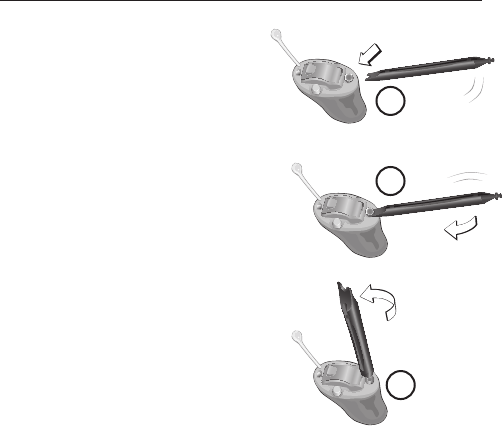
39
Bliss · Custom user guide
·Using the removal end (A),
place it under the T-Cap
edge, and push it under
the top edge of the used
T-Cap
·Lift the used T-Cap up
and out
·Using the other end of
the tool (B), insert the
new T-Cap into the opening
and slightly twist the handle
so that the new T-Cap is
free
·Discard the tool and
the used T-Cap filter
BL_ILLU_miniBTE_TCap2_BW_Hi
8
A
BL_ILLU_miniBTE_T_Cap3_BW_Hi
9
A
BL_ILLU_miniBTE_T_Cap4_BW_Hi
10
B
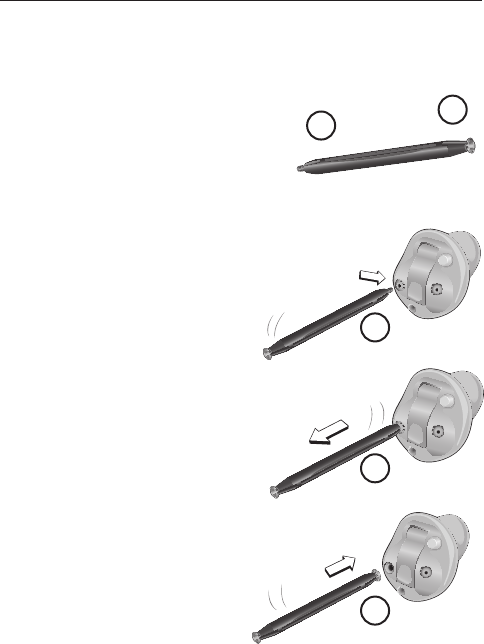
40 sonic · BLiss
How to Replace the O-Cap Filter
(for ITEPDW and ITCPDW)
The tool has two ends,
one for removal of the O-Cap (A)
and one with the new O-Cap
attached (B).
·Using the removal end (A),
insert it into the opening
of used O-Cap and pull it
out slowly. Keep the stick
straight.
·Using the other end
of the tool (B), insert
the new O-Cap into
the opening and gently
remove the stick.
·Discard the tool
and the used
O-Cap filter.
BL_ILLU_miniBTE_O_Cap1_BW_Hi
11
AB
BL_ILLU_miniBTE_O_Cap2_BW_Hi
12
A
BL_ILLU_miniBTE_O_Cap3_BW_Hi
13
A
BL_ILLU_miniBTE_O_Cap4_BW_Hi
14
B
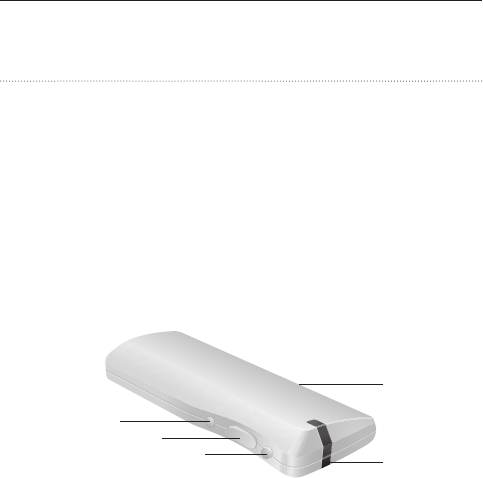
41
Bliss · Custom user guide
Operating your Bliss with the RC-P
Remote Control
Optional Accessory for ITEPDW, ITCPDW
If you have purchased a remote control, you can use
it to change listening programs, adjust the volume
level up and down, or mute the hearing instruments.
For complete operating instructions, please read
the separate RC-P Remote User Guide.
3
2
1
4
5
1 Program cycle button
2 Volume control
3 Mute button
4 Status light
5 Key lock
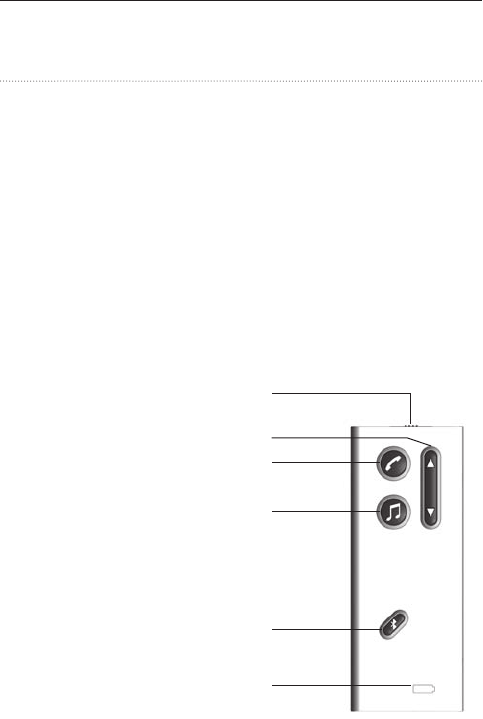
42 sonic · BLiss
1 Volume control
and program change
2 Phone
3 Music/Audio key
(e.g. MP3)
4 Bluetooth® key
5 Battery indicator
6 Key lock
1
2
3
4
6
5
Operation Your Bliss with the SoundGate
Communication Device
Optional Accessory for ITEPDW, ITCPDW
If you have purchased a SoundGate, you may use it
to perform basic functions such as changing the
listening programs, adjusting the volume level up
and down, or muting the hearing instruments. In
addition, the SoundGate serves as a link between
your hearing instruments and external sources
such as music players, cell phones, computers, etc.
For complete operating instructions, please read
the separate SoundGate User Guide.

43
Bliss · Custom user guide
Environmental Protection
Your hearing instruments contain electronic
components subject to the Directive 2002/96/EC on
waste electrical and electronic equipment (WEEE).
Help to protect the environment by not disposing
of your hearing instruments or batteries with your
unsorted household waste. Please recycle your
hearing instruments and batteries according to your
local regulations or return them to your hearing
care provider for disposal.

44 sonic · BLiss
Product Approval, Markings
and Compliance
All Sonic hearing instruments comply with international
standards concerning electromagnetic compatibility.
Due to the limited space available on the hearing
instruments all relevant approval markings are found
in this document.
Electromagnetic Interference
Your hearing instrument has been thoroughly tested
for electromagnetic interference. However, some
products may emit electromagnetic energy causing
unforeseen interference with hearing instruments.
Examples include induction cooking appliances,
shop alarm systems, mobile phones, fax machines,
personal computers, X-rays, CT scans, etc.
Even though your hearing instruments are designed
to comply with the most stringent international
standards of electromagnetic compatibility, they
may emit electromagnetic energy that can cause
interference with other devices.
Your hearing instruments contain a radio transmitter
using short range magnetic induction technology
working at 3.84 MHz. The magnetic field strength
of the transmitter is < -42 dBμA/m @ 10 m.

45
Bliss · Custom user guide
The electromagnetic emission from the radio system
is well below international limits for human exposure.
By comparison, the electromagnetic energy of the
hearing instruments is lower than that generated by
household items such as halogen lamps, computer
monitors, dishwashers etc.

46 sonic · BLiss
Cell Phone and Hearing Instrument
Compatibility
Some hearing instrument users have reported a
buzzing sound in their devices when they are
using cell phones, indicating that the cell phone
and hearing instrument may not be compatible.
The compatibility of a particular hearing instrument
and cell phone can be predicted by adding the rating
for the hearing instrument immunity to the rating
for the cell phone emissions (ANSI C63.19-2006).
The standard qualifies the M-rating (hearing
instrument in Microphone mode) and the T-rating
(hearing instrument in Telecoil mode, if an inductive
coil is available).
For example, the sum of a hearing instrument with
a rating of 2 (M2/T2) and a telephone with a rating
of 3 (M3/T3) would result in a combined rating of 5.
According to the standard, any combined rating
that equals at least 5 would provide “normal use”;
a combined rating of 6 or greater would indicate
“excellent performance.”
The immunity of your Bliss hearing instrument is
at least M2 or M2/T2 respectively.

47
Bliss · Custom user guide
The equipment performance measurements,
categories and system classifications are based
upon the best information available but Sonic
cannot guarantee that all users will be satisfied.
Note!
The performance of individual hearing
instruments may vary with individual
cell phones. Please try this hearing
instrument with your cell phone or, if you
are purchasing a new phone, be sure
to try it with your hearing instrument
prior to purchase. For additional guidance,
please ask your cell phone provider for
the booklet entitled “Hearing Aid
Compatibility with Digital Wireless Cell
Phones.“

48 sonic · BLiss
Warranty and Repairs
Your hearing instruments have a limited warranty,
covering defects in materials and workmanship.
This warranty covers the hearing instruments
themselves, but not accessories such as batteries,
tubing, domes, earmolds, etc.
This warranty is void if a defect is the result of
misuse or mistreatment. The warranty is also void
if the hearing instruments have been repaired
by non-authorized service personnel.
Please review the warranty with your hearing care
provider and make sure that your warranty card is
completed correctly.
Note!
Your hearing care provider may charge
a service fee for processing warranty repairs.

49
Bliss · Custom user guide
Accessories
Sonic offers a wide range of optional accessories
that may be purchased to enhance your hearing
system. Depending on hearing instrument type and
local regulations, the following accessories are
available:
·RC-P Remote Control
·SoundGate communication device (for wireless
connection to cell phones, music players, etc.)
·TV Adapter (for wireless connection to your television
via the SoundGate)
·Phone Adapter (for wireless connection to your
landline phone via the SoundGate)
For further information on accessories please contact
your hearing care provider.

50 sonic · BLiss
Problem Possible cause Solution
Instrument
whistles
or squeals
Instrument not inserted correctly Re-insert instrument
Ear wax accumulation in ear canal Consult your hearing care provider or physician
Instrument may be too loose Consult your hearing care provider
No volume, level
too soft or
humming noise
Instrument may not be turned ON Check that the battery door is closed completely
Battery may be dead
or inserted wrong way
Insert a fresh battery
Volume level too soft Increase volume level with volume control
on RC-P or SoundGate (if available)
Instrument may be in
telephone program
Check to make sure you are in the intended program
Ear wax accumulation in ear canal Consult your hearing care provider or physician
Battery contacts may be dirty
or corroded
Open and close the battery door several times or
clean the battery contacts carefully with a dry Q-tip
Sound outlet may be blocked
or corroded
Check the sound outlet and change the filter
if you can see that it is clogged
Microphone sound inlet may be
blocked
Consult your hearing care provider, do not try
to clean this yourself
Your hearing loss may have
increased
Consult your hearing care provider
Common Problems and Solutions

51
Bliss · Custom user guide
Problem Possible cause Solution
Instrument
whistles
or squeals
Instrument not inserted correctly Re-insert instrument
Ear wax accumulation in ear canal Consult your hearing care provider or physician
Instrument may be too loose Consult your hearing care provider
No volume, level
too soft or
humming noise
Instrument may not be turned ON Check that the battery door is closed completely
Battery may be dead
or inserted wrong way
Insert a fresh battery
Volume level too soft Increase volume level with volume control
on RC-P or SoundGate (if available)
Instrument may be in
telephone program
Check to make sure you are in the intended program
Ear wax accumulation in ear canal Consult your hearing care provider or physician
Battery contacts may be dirty
or corroded
Open and close the battery door several times or
clean the battery contacts carefully with a dry Q-tip
Sound outlet may be blocked
or corroded
Check the sound outlet and change the filter
if you can see that it is clogged
Microphone sound inlet may be
blocked
Consult your hearing care provider, do not try
to clean this yourself
Your hearing loss may have
increased
Consult your hearing care provider

52 sonic · BLiss
Problem Possible cause Solution
Whirring noise,
fading, weak
or motor-boating
sounds
Battery contacts may be dirty
or corroded
Open and close the battery door several times
or clean the battery contacts with a dry Q-tip
Moisture in hearing instrument Place hearing instrument in Dry-Instrument pack.
Remove battery first. Consult your hearing care
provider.
Low battery Insert a fresh battery
Instrument
switches from
ON to OFF
periodically
Low battery Insert a fresh battery

53
Bliss · Custom user guide
Problem Possible cause Solution
Whirring noise,
fading, weak
or motor-boating
sounds
Battery contacts may be dirty
or corroded
Open and close the battery door several times
or clean the battery contacts with a dry Q-tip
Moisture in hearing instrument Place hearing instrument in Dry-Instrument pack.
Remove battery first. Consult your hearing care
provider.
Low battery Insert a fresh battery
Instrument
switches from
ON to OFF
periodically
Low battery Insert a fresh battery

54 sonic · BLiss
Information for the Hearing Care Provider
A hearing care provider should advise a prospective
hearing instrument user to consult with a licensed
physician (preferably an ear specialist) promptly,
before dispensing a hearing instrument, if the hearing
care provider determines through inquiry, actual
observation or review of any other available
information concerning the prospective user, that
the prospective user has any of the following
conditions:
·Visible congenital or traumatic deformity
of the external or middle ear
·History of active drainage from the ear within
the previous 90 days
·History of sudden or rapidly progressive hearing
loss within the previous 90 days
·Acute or chronic dizziness or vertigo
·Unilateral hearing loss of a sudden or recent onset
within the previous 90 days
·Audiometric air-bone gap equal to or greater than
15 decibels at 500 hertz (Hz), 1000 Hz, and 2000 Hz
·Visible evidence of significant cerumen accumulation
or a foreign body in the ear canal
·Pain or discomfort in the ear

55
Bliss · Custom user guide
Warning to Hearing Care Provider and Patient
Special care should be exercised in selecting and
fitting a hearing instrument whose maximum sound
pressure level exceeds 132 decibels due to the fact
that there may be risk of impairing the remaining
hearing of the hearing instrument user.
Children with Hearing Loss
A child with a hearing loss should be directed to
a physician for medical evaluation and to other
professionals for evaluation and rehabilitation since
hearing loss may cause problems with language
development and the educational and social growth
of a child.

56 sonic · BLiss
Compliance with Requirements for Europe
This device is in conformance with the requirements
of the Directive 93/42/EEC of the Council of the
European Communities concerning medical devices,
MDD. This is certified by applying this marking.
This device also complies with the essential
requirements of the Directive 1999/5/EC of the
European Parliament on radio equipment and
telecommunications terminal equipment, R&TTE.
It operates as an inductive application in a
harmonized frequency band according to the
Commission Decision 2008/432/EC and may
be used in all member states of the EU and EFTA.
This is certified by applying this marking.
Declarations of conformity are available at:
Sonic Innovations, Inc.
2501 Cottontail Lane
Somerset, NJ 08873

57
Bliss · Custom user guide
Compliance with Radio Communications
Requirements for the USA and Canada
Sonic Innovations, Inc.
Bliss hearing instruments models BL100 ITCPDW,
BL100 ITEPDW, BL80 ITCPDW, BL80 ITEPDW
FCC ID: ZTOF2ITE01
IC: 9799A-F2ITE01
This device complies with part 15 of the FCC Rules and
RSS-210 of Industry Canada. Operation is subject to
the following two conditions:
(1) This device may not cause harmful interference,
and
(2) This device must accept any interference received,
including interference that may cause undesired
operation.
This Class B digital apparatus complies with
Canadian ICES-003.
Note!
This equipment has been tested and found
to comply with the limits for a Class B digital
device, pursuant to part 15 of the FCC Rules.

58 sonic · BLiss
These limits are designed to provide reasonable
protection against harmful interference in a residential
installation.
This equipment generates, uses, and can radiate radio
frequency energy and, if not installed and used in
accordance with the instructions, may cause harmful
interference to radio communications. However,
there is no guarantee that interference will not occur
in a particular installation.
If this equipment does cause harmful interference to
radio or television reception, which can be determined
by turning the equipment off and on, the user is
encouraged to try to correct the interference by one or
more of the following measures:
·Reorient or relocate the receiving antenna
·Increase the separation between the equipment
and receiver
·Connect the equipment into an outlet on a circuit
different from that to which the receiver is connected
·Consult the dealer or an experienced radio/TV
technician for help

59
Bliss · Custom user guide
Note!
Changes or modifications not expressly
approved by Sonic could void the user’s
authority to operate the equipment.
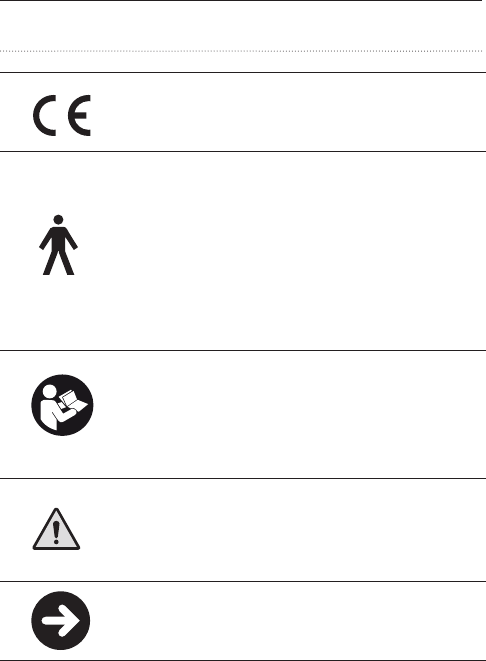
60 sonic · BLiss
Information and Explanation of Symbols
The CE conformity marking indicates
conformance to all applicable
European Directives
This symbol indicates that the
products described in these
instructions for use adhere to the
requirements for an application
part of Type B of EN 60601-1.
The surface of the hearing instrument
is specified as application part
of Type B
This symbol indicates that it is impor-
tant for the user to read
and take into account the relevant
information in these instructions
for use
This sign indicates important safety
information that must be observed
to minimize risks or to avoid
hazardous situations
Important information for handling
and product safety

61
Bliss · Custom user guide
The crossed-out wheeled bin
indicates that the European Directive
on waste of electronic equipment
applies
Operating
conditions
The product is designed such
that it functions without problem
or restrictions if used as intended,
unless otherwise noted in these
instructions for use
Transport
and storage
conditions
During transport or storage,
the temperature should not exceed
the limit value of –13°/140° Fahrenheit
(–25°/60° Celsius)

62 sonic · BLiss
Service
If none of the actions listed in the previous pages
correct a problem you may have with your hearing
instrument, contact your authorized Sonic service
representative. Do not attempt to service your
hearing instruments yourself or your warranty may
be voided.
Place stamp with dispenser name and address here:
125946 | UK
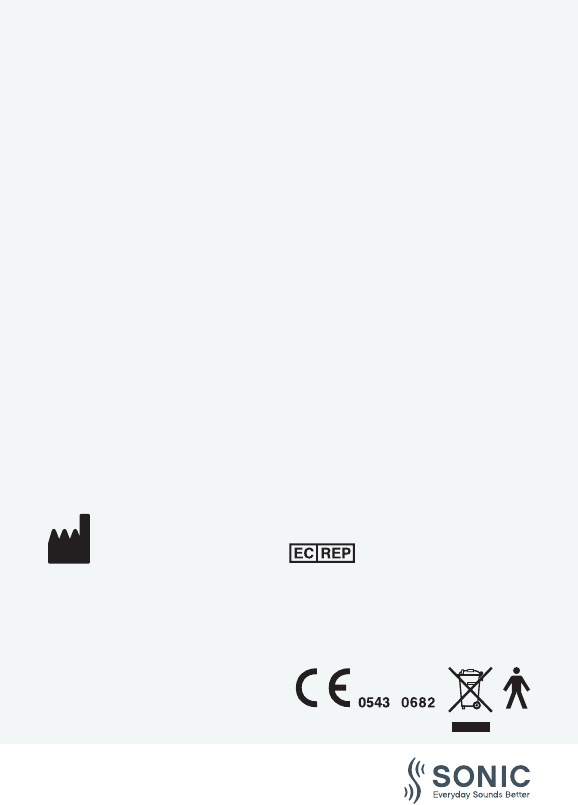
09.12 | 125946 | UK
www.sonici.com
Sonic AG
Morgenstrasse 131B
3018 Bern, Switzerland
+41 31 560 21 21
Sonic Innovations, Inc.
2501 Cottontail Lane
Somerset, NJ 08873 USA
+1 888 423 7834
World Headquarters
Sonic Innovations, Inc.
2501 Cottontail Lane
Somerset, NJ 08873 USA
+ 1 888 423 7834
Canada
Sonic Innovations Canada Ltd.
2885-B le Corbusier Blvd
Laval, Québec H7L 4J5
+ 1 800 667 7664
Australia
Sonic Australia
1/10 Dorsey Street
Milton, QLD 4064, Australia
Tel: + 61 7 3368 4044
Free call (Australia only)
1800 639 263
International
Sonic AG
Morgenstrasse 131B
3018 Bern, Switzerland
+ 41 31 560 21 21
France
Sonic France
Parc des Barbanniers
3 allée des Barbanniers
CS 40006
92635 Gennevilliers cedex
+33 1 41 88 00 88
Germany
Sonic Hörgeräte GmbH
Nunsdorfer Ring 14
12277 Berlin
+ 49 30 24 63 28 0
Italy
Sonic Italia
Piazza delle Crociate 16
00162 Roma
+ 39 06 44 24 68 52